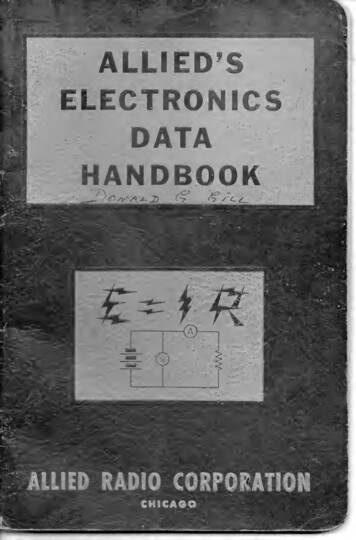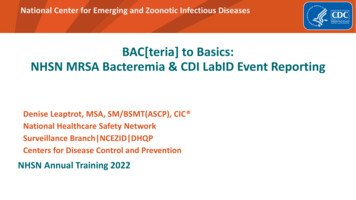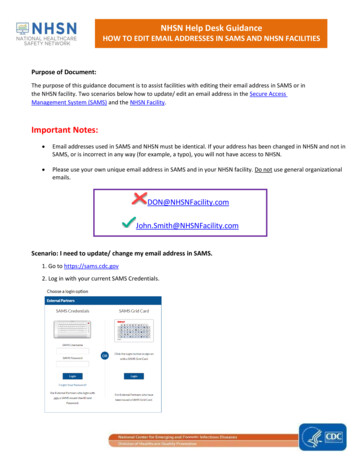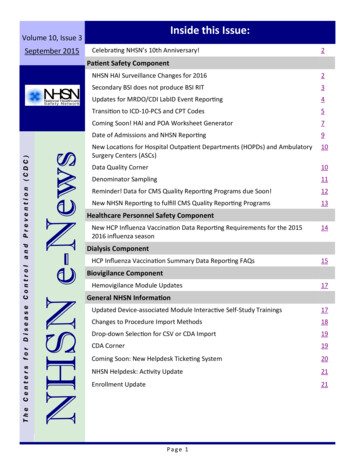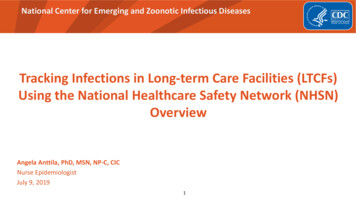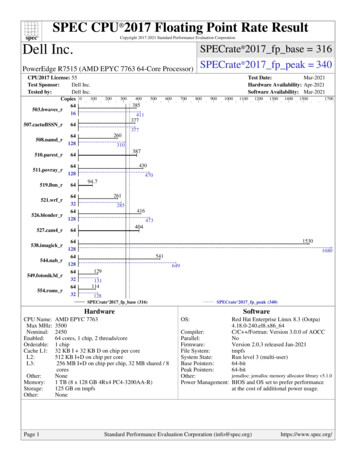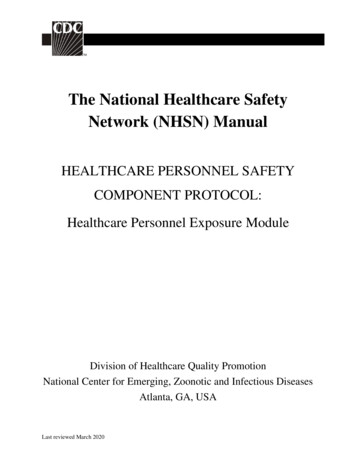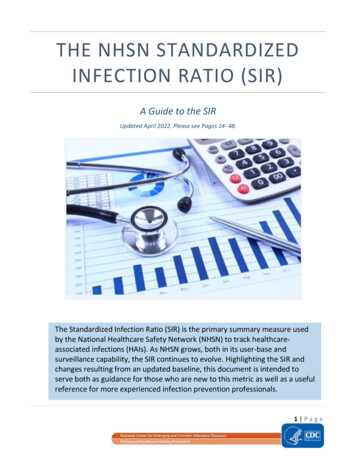
Transcription
THE NHSN STANDARDIZEDINFECTION RATIO (SIR)A Guide to the SIRUpdated April 2022. Please see Pages 14- 48.The Standardized Infection Ratio (SIR) is the primary summary measure usedby the National Healthcare Safety Network (NHSN) to track healthcareassociated infections (HAIs). As NHSN grows, both in its user-base andsurveillance capability, the SIR continues to evolve. Highlighting the SIR andchanges resulting from an updated baseline, this document is intended toserve both as guidance for those who are new to this metric as well as a usefulreference for more experienced infection prevention professionals.1 Page
CORRECTIONS AND UPDATES AS OF APRIL 2022Recent changes to this document are listed here: Page 14: An additional point added in the SIR Guide Supplement specifying ‘Derived Variables.’Page 17: A note added to specify that CLABSI events with missing denominator data (temporaryor permanent) for Specialty Care Area (SCA) locations will be excluded from SIR calculations.Page 18: Addition of specific NICU location types on the CLABSI NICU model table.Page 18: An additional note added to specify that denominator data for NICU locations arecalculated by birthweight codes.Page 20: Addition of full risk-adjusted model details for the MBI-LCBI SIR in Acute Care Hospitals(ACHs).Page 34: A reference link of the addendum added to the SSI Note section for All-SSI and theComplex A/R models.Page 35: A note added indicating that Tables 3c to 3f have been moved from the SSI section andare now available in the addendum of the SIR guide.Pages 15, 20, 23, 28, and 31: A note was added to specify that location types not listed in therisk-adjusted models are excluded from SIR calculations.Pages 15, 20, 23, 28, 31, 33, 37, 39, 46, and 48: An additional note was added to specify thatdata from facilities enrolled in NHSN as Public Health Emergency (PHE) facilities are excludedfrom SIR calculations.2 Page
Table of ContentsOverview of the Standardized Infection Ratio (SIR) 4Calculating the Number of Predicted Infections 5Example: Logistic Regression Model (SSI) 5Example: Negative Binomial Regression Model 8Finding and Interpreting SIRs in NHSN 11How do I Interpret the SIRs? 12SIR Guide Supplement: Risk Adjustment Factors Included in the SIR, 2015 Baseline 14Introduction to the SIR Guide Supplement 14CLABSI – Central Line-Associated Bloodstream Infection 15MBI-LCBI – Mucosal Barrier Injury Laboratory-Confirmed Bloodstream Infection 20CAUTI – Catheter-Associated Urinary Tract Infection 23VAE – Ventilator-Associated Events 27a) Total VAE in Long-Term Acute Care Hospitals (LTACHs) 27b) Infection-related Ventilator-Associated Complication (IVAC) Plus in LTACHs 27c) Total VAE in Acute Care Hospitals (ACHs) 25d) Infection-related Ventilator-Associated Complication (IVAC) Plus in ACHs 28SSI – Surgical Site Infections 30MRSA Bacteremia Laboratory-Identified Events 40Clostridioides difficile (CDI) Laboratory-Identified Events 42Using an Intercept-Only Model to Calculate the Number of Predicted Events 42Additional Resources 43ADDENDUM TO THE NHSN GUIDE TO THE SIR 45Hospital Outpatient Department (HOPD) Procedure/SSI SIR Model 46Outpatient Procedure Component Surgical Site Infections (OPC SSI) 513 Page
Overview of the Standardized Infection Ratio (SIR)What is the SIR?The standardized infection ratio (SIR) is a summary measure used to track HAIs at a national, state, or local levelover time. The SIR adjusts for various facility and/or patient-level factors that contribute to HAI risk within eachfacility. The method of calculating an SIR is similar to the method used to calculate the Standardized MortalityRatio (SMR), a summary statistic widely used in public health to analyze mortality data. In HAI data analysis, theSIR compares the actual number of HAIs reported to the number that would be predicted, given the standardpopulation (i.e., NHSN baseline), adjusting for several risk factors that have been found to be significantlyassociated with differences in infection incidence. In other words, an SIR greater than 1.0 indicates that moreHAIs were observed than predicted; conversely, an SIR less than 1.0 indicates that fewer HAIs were observedthan predicted. SIRs are currently calculated in NHSN for the following HAI types: central line-associatedbloodstream infections (CLABSI), mucosal barrier injury laboratory-confirmed bloodstream infections (MBI-LCBI),catheter-associated urinary tract infections (CAUTI), surgical site infections (SSI), Clostridioides difficile infections(CDI), methicillin-resistant Staphylococcus aureus bloodstream infections (MRSA), and ventilator-associatedevents (VAE).Why not rates?In the past, NHSN has published annual HAI rates for device-associated infections. These rates, or pooled means,were calculated using aggregate data reported to NHSN. The total number of infections was divided by theapplicable number of device days for that time period. However, a problem with strictly using pooled meanrates is that they cannot reflect differences in risk between populations, and therefore lose comparability overtime and across entities. For example, calculating rates from two facilities serving entirely different patientpopulations can lead to an unfair comparison. One solution to this problem is the stratification of pooled means,as was done with location-stratified CLABSI and CAUTI pooled means. However, this method only allows forcomparison of rates within strata and does not lend itself to calculating an overall performance metric for afacility.Instead, the SIR allows users to summarize data by more than a single stratum (e.g., location or procedurecategory), adjusting for differences in the incidence of infection among the strata. For example, NHSN allowsusers to obtain one CLABSI SIR for their facility, adjusting for all locations reported. Similarly, users can alsoobtain one CLABSI SIR for all intensive care units in their facility.Additionally, the SIR allows for a comparison to the national benchmark from a baseline time period, and can beused to measure progress from a single point in time. In other words, the SIR permits comparisons between thenumber of infections experienced by a facility, group, or state to the number of infections that were predictedto have occurred based on national data (i.e., baseline data).4 Page
How is the SIR calculated?The SIR is calculated by dividing the number of observed infections by the number of predicted infections. Thenumber of predicted infections is calculated using multivariable regression models generated from nationallyaggregated data during a baseline time period. These models are applied to a facility’s denominator and riskfactor data to generate a predicted number of infections. Please refer to the SIR Guide Supplement at the end ofthis document for more details regarding the models.𝑆𝐼𝑅 𝑂𝑏𝑠𝑒𝑟𝑣𝑒𝑑 (𝑂) �� (𝑃) 𝐻𝐴𝐼𝑠In order to enforce a minimum precision criterion, SIRs are currently not calculated when the number ofpredicted infections is less than 1.0. This rule was instituted to avoid the calculation and interpretation ofstatistically imprecise SIRs, which typically have extreme values.Calculating the Number of Predicted InfectionsThe number of predicted infections in NHSN is calculated based on the 2015 national HAI aggregate data and isadjusted for each facility using variables found to be significant predictors of HAI incidence. NHSN uses either alogistic regression model or a negative binomial regression model to perform this calculation. Logistic regressionmodels are used when there is an opportunity for a single outcome for each exposure (e.g., SSI following aprocedure). Negative binomial regression models are used when estimating incidence from a summarizedpopulation (e.g., CLABSIs in a Medical ICU). Examples in applying each model type are provided below. Example: Logistic Regression Model (SSI)The logistic regression model is the specific type of model used for surgical site infection risk adjustment. At ahigh level, the model uses a set of fixed parameters (adjustment variables) to predict the log-odds of a surgicalsite infection following an inpatient procedure. To obtain the total number of predicted SSIs, the following stepsare completed in NHSN:1. Determine the log-odds for each procedure2. Convert the log-odds into a probability, or risk of infection (𝑝̂ ), for each procedure3. Sum the risk of infections across all procedures in a given timeframeThe sum of the risks from a set of procedures will amount to the total number of predicted infections for thatsame set of procedures. Table 1 below shows the risk factors found to be significant for abdominal hysterectomy(HYST) procedures (Complex 30-Day model) in NHSN. Note that each risk factor’s contribution to the SIR varies,as represented by the parameter estimate for each factor. Parameter estimates describe the relationshipbetween the variable and the risk of SSI; positive parameter estimates indicate that the risk of SSI increases with5 Page
increasing values of the variable. Negative parameter estimates indicate that the risk of SSI decreases withincreasing values of the variable.Table 1. Risk Factors for SSI HYST: Complex 30-Day Model (2015 Baseline)FactorInterceptDiabetesParameter Estimate-5.18010.3247P-value 0.0001ASA Score0.4414 0.0001Body Mass Index (BMI)0.11060.0090Patient AgeOncology Hospital-0.15010.5474 0.00010.0005Variable CodingYes 1No 01 12 23 34/5 4 30 1 30 0Patient’s age/10Oncology hospital 1Non-oncology hospital 0The parameter estimates from Table 1 can be plugged into the following general logistic regression formula:𝑙𝑜𝑔𝑖𝑡 (𝑝̂ ) 𝛼 𝛽1 𝑋1 𝛽2 𝑋2 𝛽𝑖 𝑋𝑖 , where:α Interceptβi Parameter EstimateXi Value of Risk Factor (Categorical variables 1 if present, 0 if not present. Refer to“Variable Coding” column in Table 1 above.)i Number of PredictorsThe probability of SSI is calculated using the logistic regression model above, by utilizing the relationshipbetween the log-odds and the probability (risk). Let’s say we have a patient (Patient 1) who is 32 years old, hasdiabetes, and a BMI score of 29. She had an ASA score of 2 and her procedure took place in an oncologyhospital. We can use the model above to plug in these values as shown below:6 Page
𝑙𝑜𝑔𝑖𝑡 (𝑝̂ ) 5.1801 0.3247(𝐷𝐼𝐴𝐵𝐸𝑇𝐸𝑆) 0.4414(𝐴𝑆𝐴) 0.1106(𝐵𝑀𝐼) 0.1501(𝐴𝐺𝐸) 0.5474(𝑂𝑁𝐶𝑂𝐿𝑂𝐺𝑌 ��� (𝑝̂ ) 5.1801 0.3247(1) 0.4414(2) 0.1106(0) 0.1501(3.2) 0.5474(1) -3.9055The value -3.9055 is the log-odds of SSI for Patient 1. To convert this value into the risk of SSI (𝑝̂ ), we must usethe logit function below:𝑝̂ 𝑒 𝑙𝑜𝑔𝑖𝑡(𝑝̂)1 𝑒 𝑙𝑜𝑔𝑖𝑡(𝑝̂)𝑝̂ 𝑒 3.90551 𝑒 3.9055𝑝̂ 0.020Note that this can also be interpreted as a 2.0% risk of SSI for Patient 1. The probability of SSI is calculated foreach procedure and then summed across all procedures to give the total number of predicted SSIs for thispopulation. Table 2 provides a partial list of 100 hypothetical patients who have undergone this particularprocedure type and demonstrates how the total number of predicted SSIs is calculated.Table 2. Risk Factors for 100 Patients Undergoing a HYST Procedure (Complex 30-Day model)PatientDiabetesASA scoreBMIAgeOncology 7.YYY.Y.SSI Identified?̂)Probability of SSI (𝒑10.02000.01910.026.00.0378 (observed SSIs) 6.750 (predicted SSIs)Notice in the above table that the probability of SSI is different for each patient, given the risk factors presentduring the reported procedure.The SIR can now be calculated for those 100 procedures as follows:𝑆𝐼𝑅 𝑂𝑏𝑠𝑒𝑟𝑣𝑒𝑑 (𝑂) 𝐻𝐴𝐼𝑠8 1.190𝑃𝑟𝑒𝑑𝑖𝑐𝑡𝑒𝑑 (𝑃) 𝐻𝐴𝐼𝑠 6.7507 Page
Example: Negative Binomial Regression ModelNegative binomial regression models are used to calculate the number of predicted events for CLABSI, MBI-LCBI,CAUTI, VAE, MRSA bacteremia LabID, and C. difficile (CDI) LabID under the 2015 baseline. Below is a generalformula for a negative binomial regression model.𝑙𝑜𝑔 (𝜆) 𝛼 𝛽1 𝑋1 𝛽2 𝑋2 𝛽𝑖 𝑋𝑖 , where:α Interceptβi Parameter EstimateXi Value of Risk Factor (Categorical variables: 1 if present, 0 if not present)i Number of PredictorsAs an example, Table 3 below represents the negative binomial regression model used to calculate the numberof predicted healthcare facility-onset (HO) CDI LabID events in acute care hospitals under the 2015 baseline.Table 3. Risk Factors Used in the Acute Care Hospital CDI LabID Event ModelFactorInterceptInpatient community-onset (CO) admission prevalence rateCDI test type EIACDI test type NAAT# ICU beds: 43# ICU beds: 20-42# ICU beds: 10-19# ICU beds: 5-9Oncology hospital (facility type HOSP-ONC)General acute care hospital (facility type HOSP-GEN)Total facility bed sizeCDI LabID surveillance in ED or 24-hour observation location(s)Teaching facility (major, graduate, or undergraduate)Parameter 610.43941.24200.37400.00030.11190.0331P-value 0.0001 0.0001 0.0001 0.0001 0.0001 0.0001 0.0001 0.0001 0.0001 0.0001 0.0001 0.00010.0028The SIR for C. difficile LabID events in an acute care hospital is calculated on the facility-wide inpatient(FacWideIN) level for each quarter. More information on the details of the LabID Event SIR calculations can befound in the SIR Guide Supplement at the end of this document.We can input the model details from Table 3 into the general negative binomial regression formula for CDI inacute care hospitals:8 Page
# predicted HO CDI For most variables shown in parentheses in the equation above, you would replace the variable name (andtherefore, multiply each parameter estimate) with a “1” or “0” depending on whether that factor is present inyour facility (Yes “1”, No “0”). The inpatient CO prevalence rate and total number of beds are continuousvariables and should be replaced with the actual values of the inpatient CO prevalence rate and total number ofbeds. The last step in the equation is to multiply the resulting value by the appropriate HAI denominator (i.e.,patient days for MRSA/CDI events, or device days for CLABSI/MBI/CAUTI/VAE). In this example, we multiply byCDI patient days.Note: in NHSN, “CDI patient days” refers to the patient days entered on Row 3 of the FacWideIN monthlydenominator forms, for an entire quarter. This value represents that total number of patient days fromall inpatient units within the facility, with the exception of NICUs, well-baby units, and CMS-certifiedrehab and psych units.Let’s walk through an example of calculating the number of predicted CDI events for an acute care hospital for2015 Q1. The facility in our example has reported 5,000 CDI patient days and 5 healthcare facility-onset CDILabID events in 2015 Q1. After running the CDI rate tables in NHSN, the facility records that their 2015 Q1 COadmission prevalence rate was 1.25 per 100 admissions. The facility was using a NAAT CDI test type, has 5 ICUbeds, is enrolled in NHSN as a children’s non-teaching hospital, and has 100 total beds. The facility has anEmergency Department, and is thus reporting CDI data from this location per NHSN protocol.In our example hospital, the completed formula looks like this:9 Page
Because the facility was not using EIA test type, was not a general or oncology hospital, and was not a teachinghospital, the associated parameters in the model were not met. Therefore, the parameter estimates for each ofthose variables were multiplied by 0 and fell out of the equation.To calculate the CDI LabID SIR, divide the number of observed HO CDI LabID events by the number of predictedHO CID LabID events. In our example:𝑆𝐼𝑅 5 𝑜𝑏𝑠𝑒𝑟𝑣𝑒𝑑 𝐻𝑂 𝐶𝐷𝐼 𝐿𝑎𝑏𝐼𝐷 𝑒𝑣𝑒𝑛𝑡𝑠 1.5063.321 𝑝𝑟𝑒𝑑𝑖𝑐𝑡𝑒𝑑 𝐻𝑂 𝐶𝐷𝐼 𝐿𝑎𝑏𝐼𝐷 𝑒𝑣𝑒𝑛𝑡𝑠10 P a g e
Finding and Interpreting SIRs in NHSNWhat SIR reports are available?To run analysis reports in NHSN, users must first generate analysis data sets (Analysis Generate Data Sets).NHSN recommends users regenerate data sets after entering new data into the application or before creatingnew reports. After data sets have been regenerated, users can select Analysis Reports from the NHSNhomepage to view HAI-specific folders. The SIR reports located in the HAI-specific folders will be calculated usingthe 2015 baselines and risk adjustment models. In addition, SIR reports are available that mirror the datasubmitted to the Centers for Medicare & Medicaid Services (CMS) Quality Reporting Programs. These reportscan be found in the analysis folder titled “CMS Reports”.SIRs can be generated for data through 2016 using the original NHSN baselines by running reports in the“Baseline Set 1” reports folder. Data representing a later time period (i.e., starting in January 2017) can only beanalyzed in NHSN using the new 2015 rebaseline models. Year 2016 is the final year of data that can use theoriginal models to calculate SIRs. See Additional Resources for information about the original SIR baselines.11 P a g e
Note: SIRs calculated under the original baseline cannot be directly compared to SIRs calculated under theupdated baseline. Additional information about NHSN Re-baseline can be found udeck /2017/Dudeck March22.pdf.How do I Interpret the SIRs?SIR If the SIR 1.0, then more HAIs were observed than predicted, based on the 2015 national aggregatedata. If the SIR 1.0, then fewer HAIs were observed than predicted, based on the 2015 national aggregatedata. If the SIR 1.0, then the same number of HAIs were observed as predicted, based on the 2015 nationalaggregate data. Remember, the SIR is only calculated when the number of predicted infections is at least 1.0. When thepredicted number of infections is less than 1.0, facilities have a few options for reviewing andinterpreting HAI data in NHSN:oA longer time period can be included in the SIR calculation in order to reach the threshold of 1.0predicted infection.oInfection rates can be used to track internal HAI incidence over time.oRun the TAP Reports to review the CAD (cumulative attributable difference, which is thedifference between the number of observed infections and the number of predicted infections,multiplied by the SIR goal). Information and guidance about running TAP reports can be found inAdditional Resources.P-value In the context of the SIR, the p-value is a statistical measure that tells us whether the number ofobserved infections is statistically significantly different than the number of predicted infections (i.e.,whether the SIR is significantly different from 1.0). NHSN calculates p-values using a mid-P exact test. Given the typical cutoff value of 0.05, if the p-value 0.05, we can conclude that the number ofobserved infections is statistically significantly different than the number of predicted infections. If the p-value 0.05, then we can conclude that the number of observed infections is not statisticallysignificantly different than the number of predicted infections.95% Confidence Interval The 95% confidence interval is a statistical range of values in which we have a high degree of confidencethat the true SIR lies.12 P a g e
If the confidence interval does not include the value of 1, then the SIR is significantly different than 1(i.e., the number of observed infections is significantly different than the number of predictedinfections).o Example: 95% confidence interval (0.85, 0.92)If the confidence interval includes the value of 1, then the SIR is not significantly different than 1 (i.e.,the number of observed infections is not significantly different than the number of predicted infections).o Example: 95% confidence interval (0.85, 1.24)If the SIR is 0.000 (i.e., the observed infection count is 0 and the number of predicted infections is 1.0),then the lower bound of the 95% confidence interval will not be calculated.As an example, let’s take a look at the CLABSI SIR output. Below is a table showing the overall CLABSI SIR for ahospital during the first quarter of 2015. During the first quarter (January– March) of 2015 (“summaryYQ”), there were 5 CLABSIs identified in ourfacility (“infCount”), and we observed a total of 1,850 central line days (“numcldays”) from the locationsunder surveillance. Based on the NHSN 2015 baseline data, 2.365 CLABSIs were predicted (“numPred”) in our facility. This results in an SIR of 2.114 (5/2.365), signifying that during this time period, our facility identifiedmore CLABSIs than were predicted. Because the p-value (“SIR pval”) is above the significance level of 0.05 and the 95% confidence interval(“sir95ci”) includes the value of 1, we can conclude that our facility’s SIR is not statistically significant; inother words, our facility did not observe a statistically significantly different number of CLABSIs thanpredicted.When analyzing these data as a Group user, an additional overall SIR will be calculated for all facilities in theGroup. More information about using the Group function in NHSN can be found ml.13 P a g e
SIR Guide Supplement: Risk Adjustment Factors Included in the SIRCalculations, 2015 BaselineIntroduction to the SIR Guide SupplementThe following pages contain information on the risk factors used in the calculation of the number of predictedevents for each HAI and facility type under the 2015 SIR baseline. This information is provided in order to aide inthe interpretation of the SIR calculations produced by NHSN. The tables displayed in this document list thevariables included in each risk adjustment model, as well as parameter estimates and standard errors. Some riskadjustment variables are broken into different levels, or categories (i.e., categorical variables), while othervariables are treated as continuous variables without any categorization. Standard errors reflect the precision ofthe parameter estimate. Categorical variables:Example: “medical school affiliation” in the CAUTI Acute Care Hospital model, page 23Variables are categorized based on significant differences in HAI risk between the categories. Parameterestimates reflect the nature of the relationship between the variable and the risk of HAI. In the case ofcategorical variables, the risk of HAI in an individual category is compared to the risk of HAI in the “referent”category. A positive parameter estimate indicates that the risk of HAI in that category (and therefore, thenumber of predicted HAIs) is higher compared to the risk of HAI in the referent category. A negative parameterestimate indicates that the HAI risk in that category is lower compared to the HAI risk in the “referent” category. Continuous variables:Example: “facility bed size” in the CDI Acute Care Hospital model, page 38Parameter estimates reflect the nature of the relationship between the variable and the risk of HAI (andtherefore, the number of predicted HAIs). For continuous variables, a positive parameter estimate indicates thatthe risk of HAI increases as the variable increases, while negative parameter estimates indicate that the risk ofHAI decreases as the variable increases. Derived variables:Example: The proportion of admissions with traumatic and non-traumatic spinal cord dysfunction in the CAUTI IRFmodel, page 26Derived variables are variables created from two or more variables, and may involve summation, division, ormultiplication. They may be categorical or continuous. Parameter estimates are interpreted as above if thederived variables are categorical or continuous.14 P a g e
Risk Adjustment Factors Included in the SIR Calculation: 2015 BaselineCLABSI – Central Line-Associated Bloodstream InfectionThe number of predicted CLABSIs is calculated using a negative binomial regression model (see page 8 above formore information). Inpatient locations that were previously excluded from the original baseline are nowincluded in the SIR under the 2015 baseline (e.g., Telemetry Ward, Mixed Acuity Ward). Refer to Table 1 belowfor a list of location types included in the Acute Care Hospital CLABSI SIR; if an inpatient location is not includedin the model table below, then data from that location type will be excluded from the SIR due to insufficient2015 baseline data. In addition, data from Governmental and Non-governmental Public Health Emergency (PHE)Facilities (facType as HOSP-PHE/G or HOSP-PHE/NG), will also be excluded from the SIR. In cases when thenumber of predicted events is less than 1.0, the SIR will not be calculated in NHSN. CLABSI events reported toNHSN as mucosal barrier injury (MBI-LCBI), or with extracorporeal life support (ECMO), or a ventricular assistdevice (VAD) (2019 events and later) are excluded from the numerator of the CLABSI SIR.The number of predicted CLABSIs calculated under the 2015 baseline is risk adjusted based on the followingvariables found to be statistically significant predictors (risk adjustment updated August 2018):Table 1. CLABSI in Acute Care Hospitals (non-NICU locations)ParameterParameter EstimateIntercept-7.6325CDC Location Code: Adult Critical Care Units, OncologyCritical Care UnitsMedical Cardiac Critical CareSurgical Cardiothoracic Critical CareMedical Critical CareMedical/Surgical Critical CareNeurologic Critical CareNeurosurgical Critical CareMedical Oncology Critical CareMedical/Surgical Oncology Critical CarePediatric Oncology Critical CareSurgical Oncology Critical CarePrenatal Critical CareRespiratory Critical CareSurgical Critical CareStandard Error0.0606P-value 0.00010.32570.0435 0.00010.56950.0699 0.00011.42690.62870.11250.0835 0.0001 0.00010.37660.13040.0039CDC Location Code: Pediatric Critical CarePediatric Burn Critical CarePediatric Cardiothoracic Critical CarePediatric Medical/Surgical Critical CarePediatric Medical Critical CarePediatric Neurosurgical Critical CarePediatric Surgical Critical CarePediatric Trauma Critical CareCDC Location Code: Burn Critical Care (Adult)CDC Location Code: Trauma Critical Care (Adult)CDC Location Code: Specialty Care AreasInpatient DialysisSolid Organ Transplant (adult)15 P a g e
ParameterParameter EstimateStandard ErrorP-value0.21550.0521 0.00010.17970.0427 0.00010.36980.0550 0.00010.68760.0816 0.00010.19120.07040.0066REFERENT--Solid Organ Transplant (pediatric)CDC Location Code: Step-down UnitsAdult Step-down UnitOncology Step-down UnitPediatric Step-down UnitStep-down Neonatal Nursery (Level II)CDC Location Code: Select Adult WardsMedical WardMedical/Surgical WardNeurology WardNeurosurgical WardSurgical WardTelemetry WardCDC Location Code: Oncology WardsONC General Hematology/Oncology WardONC Pediatric General Hematology/Oncology WardONC Leukemia WardONC Leukemia/Lymphoma WardONC Lymphoma WardONC Solid Tumor WardCDC Location Code: Oncology Stem Cell TransplantWardsONC Hematopoietic Stem Cell Transplant Ward (adult)ONC Pediatric Hematopoietic Stem Cell Transplant WardCDC Location Code: Pediatric Wards & NurseriesPediatric Behavioral Health WardPediatric Burn WardPediatric Medical WardPediatric Medical/Surgical WardPediatric Neurosurgical WardWell Baby Nursery (Level I)Pediatric Neurology WardPediatric Orthopedic WardPediatric Rehabilitation Ward (non-CMS)Pediatric Surgical WardCDC Location Code: All Other WardsAdult Mixed AcuityMixed Age Mixed AcuityPediatric Mixed AcuityOncology Mixed AcuityAntenatal Care WardBurn WardBehavioral Health/Psych WardAdolescent Behavioral Health WardEar/Nose/Throat WardGastrointestinal WardGerontology WardGenitourinary Ward16 P a g e
ParameterGynecology WardJail UnitLabor and Delivery WardLabor, Delivery, Recovery, Postpartum Suite (LDRP)Orthopedic WardPlastic Surgery WardPostpartum WardPulmonary WardRehabilitation Ward (non-CMS)Stroke (Acute) WardOrthopedic Trauma WardVascular Surgery WardChronic Care UnitChronic Behavioral Health/Psychiatric UnitInpatient HospiceChronic Ventilator DependentChronic Rehabilitation UnitFacility bed size*: 224 bedsFacility bed size*: 94 - 223 bedsFacility bed size*: 93 bedsMedical school affiliation*: MajorMedical school affiliation*: GraduateMedical school affiliation*:Undergraduate/Non-teachingFacility type: (based on NHSN enrollment)Parameter EstimateREFERENT(continued fromprevious page)Standard RENT0.14290.04710.04930.02110.02440.0526 0.00010.0187 0.0001 ’ AffairsWomen’sWomen’s and Children’sFacility type: (based on NHSN enrollment)General Acute CareOncologyOrthopedicPsychiatricSurgical* Facility bed size and medical school affiliation are taken from the Annual Hospital Survey.Note: For data from Specialty Care Areas and Oncology locations, CLABSI events are eligible for inclusion in the SIRregardless of the type of central line (temporary or permanent). Similarly, total central line days (numcldays) used in the SIRcalculation are summed from temporary and permanent central line days reported. If a CLABSI event is reported from amonth/location with missing denominator data for either temporary or p
The number of predicted infections in NHSN is calculated based on the 2015 national HAI aggregate data and is adjusted for each facility using variables found to be significant predictors of HAI incidence.


